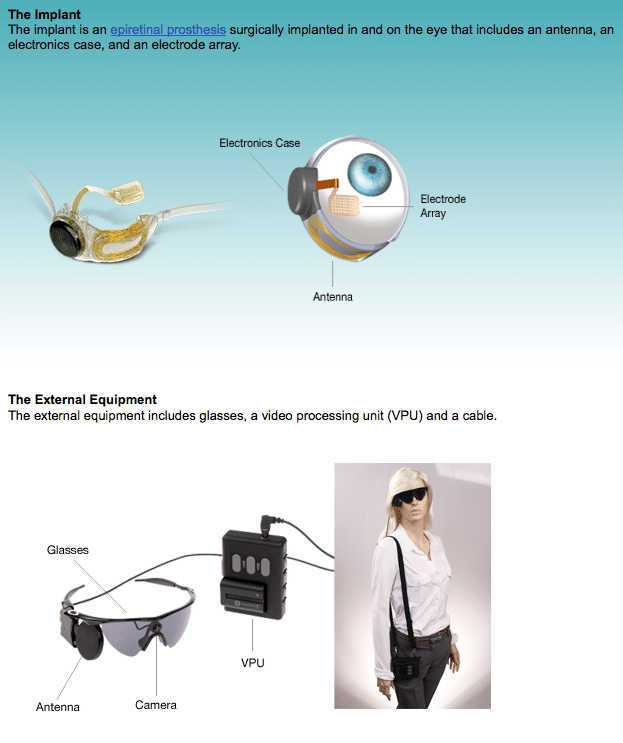
This is very exciting news for the realm of artificial vision. I have someone I look up to that suffers from Retinitis Pigmentosa, and it sucks to see this degenerative disease affect this man’s sight.
But: advances are being made in “bionic” tech all the time that tries to bridge the gap between natural vision and artificially enhanced vision – and since we don’t understand that much about how the brain translates sight into information for the brain, every time there is a breakthrough in technology in this arena, it’s a big deal!
First, what is Retinitis Pigmentosa? It sounds like something that is not very good, and in fact it is not. From Wikipedia and the NIH:

Retinitis pigmentosa (RP) is an inherited, degenerative eye disease that causes severe vision impairment and often blindness.[1] Sufferers will experience one or more of the following symptoms:
- Night blindness or nyctalopia;
- Tunnel vision (no peripheral vision);
- Peripheral vision (no central vision);
- Latticework vision;
- Aversion to glare;
- Slow adjustment from dark to light environments and vice versa;
- Blurring of vision;
- Poor color separation; and
- Extreme tiredness.
The progress of RP is not consistent. Some people will exhibit symptoms from infancy, others may not notice symptoms until later in life.[2] Generally, the later the onset, the more rapid is the deterioration in sight. Also notice that people who do not have RP have 90 degree peripheral vision, while some people that have RP have less than 90 degree.
A form of retinal dystrophy, RP is caused by abnormalities of the photoreceptors (rods and cones) or the retinal pigment epithelium (RPE) of the retina leading to progressive sight loss. Affected individuals may experience defective light to dark, dark to light adaptation or nyctalopia (night blindness), as the result of the degeneration of the peripheral visual field (known as tunnel vision). Sometimes, central vision is lost first causing the person to look sidelong at objects.
The effect of RP is best illustrated by comparison to a television or computer screen. The pixels of light that form the image on the screen equate to the millions of light receptors on the retina of the eye. The fewer pixels on a screen, the less distinct will be the images it will display. Fewer than 10 percent of the light receptors in the eye receive the colored, high intensity light seen in bright light or daylight conditions. These receptors are located in the center of the circular retina. The remaining 90 percent of light receptors receive gray-scale, low intensity light used for low light and night vision and are located around the periphery of the retina. RP destroys light receptors from the outside inward, from the center outward, or in sporadic patches with a corresponding reduction in the efficiency of the eye to detect light. This degeneration is progressive and has no known cure as of June 2012.
That sucks so much. However, now you have to meet Second Sight Medical Products’ Argus® II Retinal Prosthesis System, which just got FDA approval for patent this week:
All I can say about this is holy crap.
From the MedGadget article on the Argus II system:
The bionic eye works by replacing the disease-damaged photoreceptors of the eye with tiny chips that translate light into electrical signals, which in turn stimulate the optic nerve. The normal retina is really not a camera, and the optic nerve does not send pixels, per say, to the brain, but rather a highly processed and optimally encoded representation of the visual scene. The fact that bionic eyes like the Argus II can work at all – and indeed so well – is due more to the brain’s ability to make sense out of whatever relevant signals it receives, than to current understanding of how the retina actually works. As researchers advance their understanding of the retina, bionic eye technology will continue to advance hand-in-hand to provide new vision to the blind at ever higher resolution.
This is amazing technology. I hope that the Argus II system can restore vision in those who have lost it due to terrible degenerative diseases like RP.
To my buddy: hang in there, big man. I’m always on the lookout.
Side note: under the Did You Know? section of the Argus II System website:
The Latin word “Argus” refers to a giant in Greek mythology with 100 eyes, Argus Panoptes, who was considered all-seeing. Argus was the servant of Hera, goddess of women and marriage as well as the wife of Zeus. Zeus seduced the nymph Io who was also the priestess of Hera. In order to hide her from Zeus, Hera transformed her into a white heifer and asked Argus to watch over Io and protect her from Zeus.
Too cool, Second Sight.





